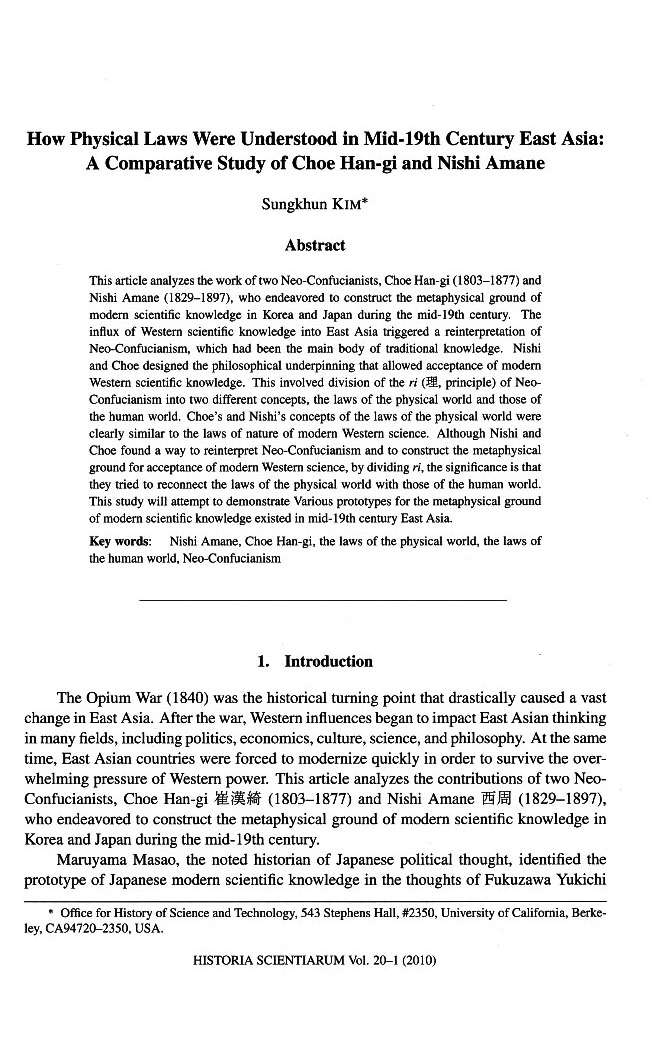Edmund C.Berkeley as a Popularizer and an Educator of Computers and Symbolic Logic(pp.1-23)
SUGIMOTO,Mai
Note
The Evolution of the Gender Question in the Study of Madame Lavoisier(pp.24-37)
KAWASHIMA,Keiko
A Survey of Geometrical Diagrams in Korean Mathematical Texts
from the 17th to the 19th Century(pp.38-58)
YING,Jia-Ming
CONTENTS
CONTENTS OF HISTORIA SCIENTIARUM, Volume 1 – Volume10
Introduction: Special Issue > Science and Soviet Political Authorities: Conflict, Cooperation, and Incongruence(pp.159-160)
ICHIKAWA,Hiroshi
Science as Co-Producer of Soviet Polity(pp.161-180)
KOJEVNIKOV,Alexei
Parallel Worlds : Formal Structures and Informal Mechanisms of Postwar Soviet Mathematics(pp.181-200)
GEROVITCH,Slava
Between Ideology and Science : Dialectics of Dispute on Physics in 1920s-1930s Soviet Russia(pp.201-214)
KANAYAMA,Koji
Soviet Physicists during the War : Jealousy, Discord and the Ideological Dispute(pp.215-226)
ICHIKAWA,Hiroshi
The Institute of Genetics frm 1939 to 1940 : Reconsidering Lysenko’s Intervention in Soviet Genetics(pp.227-236)
SAITO,Hirofumi
CONTENTS
CONTENTS OF HISTORIA SCIENTIARUM, VOLUME 22
Introduction: Special Issue > Social History of Medicine in Modern Japan(pp.63-67)
SUZUKI,Akihito
Translating Medical Knowledge : Japan’s First Medical Journal – Taisei meii iko『泰西名医彙講』(pp.68-87)
JANNETTA,Ann
Relocating Psychiatric Knowledge : Meiji Psychiatrists, Local Culture(s), and the Problem of Fox Possession(pp.88-109)
BURNS,Susan L.
Popularization of Psychiaric Knowledge in Modern Japan at the Turn of the Twentieth Century : Focusing on the Newspaper Coverage of Mental Disorders(pp.110-124)
SATO,Masahiro
From the Laboratory to the Kitchen : The Oral History of Nutrition and its Application to the History of Science(pp.125-141)
RIE,Hogetsu
Nation from the Bottom Up : Disease, Toilets and Waste Management in Prewar Japan(pp.142-158)
BAY,Alexander R.
Aristotle on the Debate about the Central Organ of the Human Body in the 5th and 4th Centuries BC(pp.1-21)
IMAI,Masahiro
Note
The Japanese Clocks and Time in the Past : Non-standard Seasonal Time Inscribed on Scale Plates of Foot-Ruler Clocks(pp.22-39)
HASHIMOTO,Takehiko
Book Review
Book Review: NISIO Sigeko, Kagaku Janarizumu no Senkusha, Hyoden, ISHIWARA Jun (A Critical Biography of Ishiwara Jun: A Pioneer in Science Journalism),Tokyo:Iwanami Shoten,2011(pp.40-42)
OKAMOTO,Takuji
News
The Program of the 59th Annual Meeting of the History of Science Society of Japan
Contents
CONTENTS OF HISTORIA SCIENTIARUM, No.19(1980)-No.42(1991)(pp.47-61)
Introduction: Special Issue > Science, Technology, and the State in East Asia: Experts and Politicians in Postwar Korea and Japan(pp.159-160)
HASHIMOTO,Takehiko
The Dual Green Revolutions in South Korea : Reforestation and Agricultural Revolution under the Authoritarian Regime(pp.161-173)
MOON,Manyong
Technoscience and Politics in Korea in the 1970s : “Scientification of All People Movement” and the “Saemaul Technical Service Corps”(pp.174-192)
LEE,Young-Mi and HONG,Sungook
Managing the Interface between Politics and Technology : Itokawa Hideo, Shima Hideo, and the Early Japanese Space Programs(pp.193-210)
SATO,Yasushi
Yokkaichi Asthma and Building the System of Certification of Pollution-related Patients in the 1960s(pp.211-227)
FENG,Danyang
CONTENTS OF HISTORIA SCIENTIARUM, VOLUME 21(pp.229-230)
Statement by The President of The History of Science Society of Japan(pp.91-92)
DOKE,Tatsumasa
Galileo’s Principle of Descending Motion along Inclined Planes(pp.93-102)
ITO,Kazuyuki
Herophilus of Chalcedon and the Hippocratic Tradition in Early Alexandrian Medicine(pp.103-122)
IMAI,Masahiro
Women’s Translations of Scientific Texts in the 18th Century : A Case Study of Marie-Anne Lavoisier(pp.123-137)
KAWASHIMA,Keiko
Introduction : Special Issue > Encounters with the West: Science, Technology and Visual Culture in East Asia from the 18th to the 19th Century(pp.1-2)
LOW,Morris and CHUNG,Hyung-Min
Perspectives in Early Qing-Dynasty Pictures of Tilling and Weaving and Pictures of Cotton(pp.3-19)
HAMMERS,Roslyn Lee
Art, Class and Gender in Joseon Dynasty Korea : Representations of Lower-Class Women by the Scholar-Painter Yun Duseo(pp.20-42)
CHUNG,Saehyang
Agricultural Illustrations of 19th Century Korea : Imwon gyeongjeji (Treatises on Management of Forest and Garden) by Seo Yugu(pp.43-65)
CHUNG,Hyung-Min
The Impact of Western Science and Technology on Ukiyo-e Prints and Book Illustrations in Late Eighteenth and Nineteenth Century Japan(pp.66-87)
LOW,Morris
Eloge
In Memorial of Fumihiko SATOFUKA(pp.88-89)
NAKAYAMA,Shigeru
Introduction : Special Issue > Historical Studies on Scientific and Pedagogical Instruments(pp.165-166)
HASHIMOTO,Takehiko
Whirling Arm and Its Role in Experimental Research on Fluid Resistance in the Eighteenth Century(pp.167-178)
NAKAZAWA,Satoshi
Detecting, Recording and Expanding : Instrumentation of Earthquake and Tsunami Observations in Meiji Japan(pp.179-195)
KIM,Boumsoung
The First Higher School’s Instruments for Science and Engineering Education(pp.196-211)
OKAMOTO,Takuji
The Physical Apparatus Collection at Kyoto University : Historical Material as Thing Knowledge(pp.212-219)
NAGAHIRA,Yukio
News
The Program of the 57th Annual Meeting of the History of Science Society of Japan
Contents
CONTENTS OF HISTORIA SCIENTIARUM, VOLUME 20
Introduction : Special Issue > Historical Studies on Scientific Experiments and Instruments(pp.61-62)
HASHIMOTO,Takehiko
Success from Different Programs : The Development of Experimental Researches on Thermal Radiation in Germany at the End of the 19th Century(pp.63-95)
KONAGAYA,Daisuke
“How Far Do Experiments on Models Represent Experiments on Full Sized Machines?” : The Examination and Dispute on the Reliability of the Wind Tunnels in Britain, 1909-1917(pp.96-122)
HASHIMOTO,Takehiko
The Strategy for Acceptance of the Scanning Tunneling Microscope: Observations of the Si(111)7×7 Reconstructed Surface, 1959-1986(pp.123-146)
YAMAGUCHI,Mari
Eloge
To the Memory of Lawrence Badash(1934-2010) (pp.147-149)
YAGI,Eri
Note
Nuclear Winter and the End of the Age of Agriculture (pp.150-163)
Badash,Lawrence
How Physical Laws Were Understood in Mid-19th Century East Asia : A Comparative Study of Choe Han-gi and Nishi Amane(pp.1-20)
KIM,Sungkhun
Far Eastern Vacuum and Electricity : Augustin Hallerstein and Experimental Correspondence between Beijing and Europe(pp.21-46)
JUZNIC,Stanislav
Note
A History of Entropy through Various Methods : Specially Focused on Technical Term Analysis(pp.47-56)
YAGI,Eri and OKAMOTO, Tadokoro Rika
Review
Book Review: Luís SARAIVA, and Catherine JAMI, eds., The Jesuits, the Padroado and East Asian Science (1552-1773)(pp.57-60)
HASHIMOTO,Takehiko




